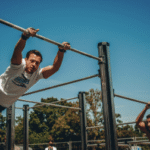Calisthenics Training Frequency: How Often Should You Train?
Determining the optimal calisthenics training frequency is crucial for maximizing your results and preventing overtraining. It’s a balancing act between providing enough stimulus for your body to adapt and grow stronger while allowing adequate time for recovery and repair. Here’s a detailed guide to help you find the right training frequency for your calisthenics journey:
Factors Influencing Training Frequency
Fitness Level:
Beginner: If you’re new to calisthenics, your body needs time to adapt to the demands of these exercises. Starting with 2-3 sessions per week allows for gradual progression and reduces the risk of excessive muscle soreness or injury.
Intermediate/Advanced: As you gain experience and strength, you can gradually increase your training frequency. Intermediate individuals might train 3-4 times per week, while advanced practitioners could handle 4-5 sessions, or even more, depending on their recovery capacity and training intensity.
Training Goals:
General Fitness: For maintaining overall fitness and health, 2-3 sessions per week may be sufficient.
Strength and Hypertrophy: If your goal is to build strength or increase muscle mass, you might benefit from more frequent training, potentially 4-5 times per week.
Skill Development: If you’re focused on mastering specific calisthenics skills like handstands or muscle-ups, you might need to adjust your training frequency based on the complexity and intensity of the skill practice.
Recovery Capacity:
Individual Factors: Factors like age, sleep quality, nutrition, stress levels, and genetics influence your recovery capacity.
Listen to Your Body: Pay attention to signs of overtraining, such as persistent fatigue, decreased performance, or increased muscle soreness. Adjust your training frequency based on how your body feels.
Training Intensity and Volume:
High-Intensity: If you’re training with high intensity, you’ll likely need more rest days to recover.
High-Volume: Similarly, if you’re performing a high volume of exercises, you might need more recovery time.
Finding Your Optimal Training Frequency
Start Slowly: Begin with a lower frequency (2-3 times per week) and gradually increase as your fitness and recovery capacity improve.
Monitor Your Progress: Track your workouts and pay attention to how your body responds. If you’re consistently feeling fatigued or sore, you might need to reduce your training frequency or incorporate more rest days.
Experiment: Try different training schedules and see what works best for you. There’s no one-size-fits-all answer, so find a frequency that allows you to make progress while feeling energized and motivated.
Consider Split Routines: As you progress, you might benefit from split routines, where you focus on different muscle groups or movement patterns on different days. This allows for more targeted training and better recovery.
Prioritize Rest and Recovery: Remember that rest and recovery are just as important as training. Incorporate active recovery days, prioritize sleep, and nourish your body with a balanced diet to support muscle repair and growth.
Sample Training Schedules
Beginner:
Monday: Full-body workout
Wednesday: Rest or active recovery
Friday: Full-body workout
Intermediate:
Monday: Upper body strength
Tuesday: Rest or active recovery
Wednesday: Lower body strength
Thursday: Rest or active recovery
Friday: Full-body circuit
Advanced:
Monday: Push-focused workout
Tuesday: Rest or active recovery
Wednesday: Pull-focused workout
Thursday: Rest or active recovery
Friday: Legs and core workout
Saturday: Skill work or active recovery
Sunday: Rest
Key Takeaways
Training frequency is a crucial factor in calisthenics progress.
Consider your fitness level, goals, recovery capacity, and training intensity when determining your ideal frequency.
Start slowly and gradually increase your training frequency as you adapt and improve.
Prioritize rest and recovery to prevent overtraining and maximize results.
Experiment with different training schedules to find what works best for you.
By finding the right balance between training and recovery, you can optimize your calisthenics journey, achieve your fitness goals, and enjoy a sustainable and rewarding fitness lifestyle.

Calisthenics Training Frequency: How Often Should You Train?
Route
Calisthenics Gym Houston Functional Bodyweight Training
Secondary phone: (346) 483-3195
Email: info@calisthenicsclubhouston.com
URL: https://calisthenicsclubhouston.com/
Monday 6:00 AM - 7:00 PM Tuesday 6:00 AM - 7:00 PM Wednesday 6:00 AM - 7:00 PM Thursday 6:00 AM - 7:00 PM Friday 12:00 PM - 6:30 PM Saturday 9:45 AM - 12:00 PM Sunday 3:00 PM - 5:00 PM





